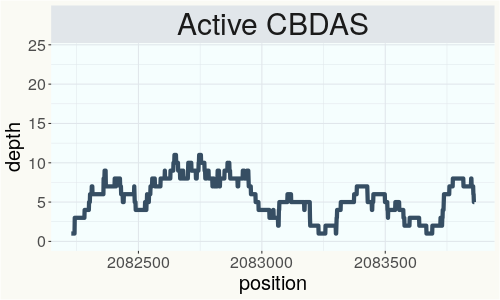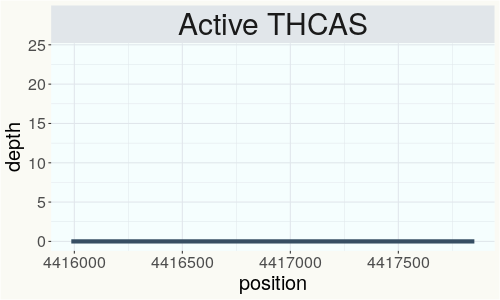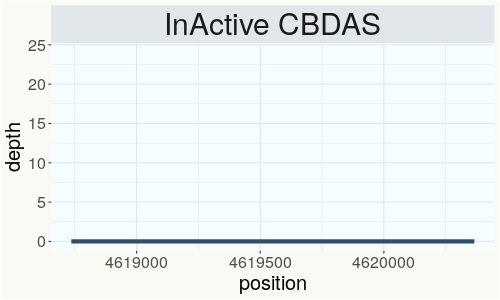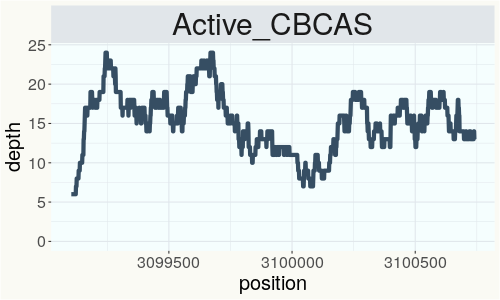Kompolti_2
SRR 3294460
General Information
- Accession Date
- February 7, 2016
- Reported Plant Sex
- Hermaphrodite
- Report Type
- Whole-Genome Sequencing
The strain rarity visualization shows how distant the strain is from the other cultivars in the Kannapedia database. The y-axis represents genetic distance, getting farther as you go up. The width of the visualization at any position along the y-axis shows how many strains there are in the database at that genetic distance. So, a common strain will have a more bottom-heavy shape, while uncommon and rare cultivars will have a visualization that is generally shifted towards the top.
Chemical Information
Cannabinoid and terpenoid information provided by the grower.
Cannabinoids
No information provided.
Terpenoids
No information provided.
Genetic Information
- Plant Type
- Type III
File Downloads
The bell curve in the heterozygosity visualization shows the distribution of heterozygosity levels for cannabis cultivars in the Kannapedia database. The green line shows where this particular strain fits within the distribution. Heterozygosity is associated with heterosis (aka hybrid vigor) but also leads to the production of more variable offspring. When plants have two genetically different parents, heterozygosity levels will be higher than if it has been inbred or backcrossed repeatedly.
The ratio of reads mapped to Y-contigs to reads mapped to the whole Cannabis genome (Y-ratios) has been demonstrated to be strongly correlated with plant sex typing. This plot shows the distribution of Y-ratios for all samples in our database which were sequenced with the same method (panel or WGS) as this sample and where this sample falls in the distribution.

This chart represents the Illumina sequence coverage over the Bt/Bd allele. These are the three regions in the cannabis genome that impact THCA, CBDA, CBGA production. Coverage over the Active CBDAS gene is highly correlated with Type II and Type III plants as described by Etienne de Meijer. Coverage over the THCA gene is highly correlated with Type I and Type II plants but is anti-correlated with Type III plants. Type I plants require coverage over the inactive CBDA loci and no coverage over the Active CBDA gene. Lack of coverage over the Active CBDA and Active THCA allele are presumed to be Type IV plants (CBGA dominant). While deletions of entire THCAS and CBDAS genes are the most common Bt:Bd alleles observed, it is possible to have plants with these genes where functional expression of the enzyme is disrupted by deactivating point mutations (Kojoma et al. 2006).



This chart represents the Illumina sequence coverage over the CBCA synthase gene.

Variants (THCAS, CBDAS, and CBCAS)
No variants to report
Variants (Select Genes of Interest)
| PHL-2 | c.2467T>C | p.Ser823Pro | missense variant | moderate | contig2621 | 342510 | T/C |
|
| PHL-2 | c.3033T>G | p.Cys1011Trp | missense variant | moderate | contig2621 | 343076 | T/G | |
| PHL-2 | c.3209A>G | p.Gln1070Arg | missense variant | moderate | contig2621 | 343252 | A/G | |
| AAE1-2 |
c.285_290dup |
p.Ser96_Ser9 |
disruptive inframe insertion | moderate | contig81 | 209243 | A/AATCCTC |
|
| EMF2 | c.1772A>G | p.Gln591Arg | missense variant | moderate | contig954 | 3059929 | A/G | |
| AAE1-3 | c.659G>A | p.Arg220Gln | missense variant | moderate | contig976 | 1083195 | C/T |
|
Nearest genetic relatives (All Samples)
- 0.054 Blue Dream (RSP11010)
- 0.057 SourD (RSP12092)
- 0.083 Blue Dream (RSP11008)
- 0.083 UC 86 (SRR14419663)
- 0.086 B52 (SRR14708255)
- 0.091 Suver Haze (RSP11364)
- 0.091 Strawnana (RSP12094)
- 0.096 Golden Goat 2 (RSP10991)
- 0.100 UC 74 (SRR14419674)
- 0.103 UC 32 (SRR14419761)
- 0.103 UC 21 (SRR14419861)
- 0.104 NSPM1 (RSP11362)
- 0.104 Super Blue Dream (RSP11011)
- 0.107 UC 167 (SRR14419585)
- 0.109 VIR 483 (SRR14708238)
- 0.109 Juso14 (SRR14708259)
- 0.111 Triangle Kush x Square Wave BX (RSP12100)
- 0.111 UC 445 (SRR14419766)
- 0.113 East side OG (RSP12089)
- 0.113 Alpine Rocket (SRR14708266)
Most genetically distant strains (All Samples)
- 0.396 80E (RSP11213)
- 0.378 JL 3rd Gen Mother (RSP11214)
- 0.377 JL yellow (RSP11075)
- 0.375 80E (RSP11212)
- 0.363 80E (RSP11211)
- 0.352 Fedora 17 (RSP10661)
- 0.350 Chematonic Cannatonic x Chemdawg (RSP11394)
- 0.333 RKM-2018-024 (RSP11116)
- 0.324 JL 4th Gen 2 (RSP11194)
- 0.317 Cbot-2019-005 (RSP11133)
- 0.315 JL 4th Gen 5 (RSP11199)
- 0.304 Danny Noonan (RSP11070)
- 0.304 JL 3rd Gen Father (RSP11196)
- 0.304 Chem 91 (RSP11185)
- 0.304 IUP2 (SRR14708257)
- 0.303 Ringo s Gift Katie s Cut (RSP11624)
- 0.303 JL 2 (RSP11076)
- 0.303 Cherry Blossom (RSP11323)
- 0.301 Cherry Blossom (RSP11318)
- 0.301 Northern Lights (RSP11501)
Nearest genetic relative in Phylos dataset
- Overlapping SNPs:
- 4
- Concordance:
- 4
Blockchain Registration Information
- SHASUM Hash
-
feba681eefc767abbc82c12f3b86cb96 05a60ba67cdfca7f fdf70edc389ac0d5